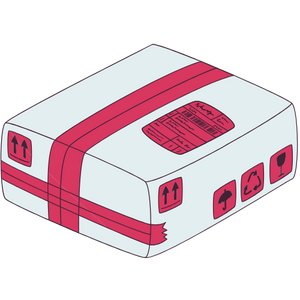Menstrual cups vs tampons: making the right choice for your health and the environment as a teen
First periods, first cycles, first hygiene products—it’s not always easy to navigate as a teenager.
Today, thanks to the many alternatives now available, our teens aren’t limited to just classic pads or disposable tampons. Reusable, durable, and washable products are also an option to support teens during their periods. Just as simple and convenient, these products offer many advantages: transparent and clean ingredients, materials that respect feminine health, product durability, a limited carbon footprint, and more. In short, health and the environment have never worked so well together when it comes to feminine protection. How do you make the right choices? Let’s look at the main arguments that compare tampons and cups: health and the environment. These are two central themes when choosing period products. Since choosing your hygiene solutions isn’t trivial, let’s take the time to discuss it together!

Teens and periods: don’t stress, communicate openly
Choosing the right protection for your teen isn’t always easy. Understanding her and informing her about the changes happening to her body isn’t either. Don’t hesitate to break the taboo or embarrassment. Periods are a natural part of a woman’s body, completely normal, not gross or dirty. In fact, they’re a sign of good health.
Several Louloucup articles can help you support your teen, reassure her, and help you find the best period protection:
- Menstrual cycle, ovulation, periods—everything you need to explain it all to your teen!
- First period: no stress, everything will be just fine!
- Everything you need to know about a teen’s first period
- Why are period panties the best choice for teens?
- Which period swimsuit should I choose for my teen?
Menstrual cup, period swimwear, or period underwear—there are several concrete, effective, and reliable alternatives to traditional pads and tampons.
Menstrual cup or tampon: which is the healthier choice during your period?
For several years now, many scientific articles and studies have shed light on the use of tampons and the health risks they can pose.
Toxic shock syndrome is by far the most serious risk. Blood that sits in a tampon for hours can create the perfect environment for bacteria (staphylococcus aureus) to grow. This bacteria releases a toxin that can severely damage your organs. If not treated quickly, this syndrome can be fatal. 20 to 30% of women carry this bacteria (source: Zava).
You absolutely must wear your tampon for less than six hours, change it regularly, and wash your hands thoroughly before and after removal. It’s especially important to know the symptoms of toxic shock: sudden fever, vomiting, faintness, diarrhea, and rash. If you have any doubts, contact emergency services immediately.
Because the menstrual cup is an internal protection, the same hygiene advice applies: wash your hands and wear the cup for a maximum of six hours. We also advise against using the cup overnight. It’s important to sterilize the cup before use. Ideally, have two menstrual cups and alternate between them to ensure proper cleaning and sterilization.
Unlike tampons, however, the cup is made from safe materials. The menstrual cup, placed at the entrance of the vagina, does not disrupt the vaginal flora, nor does it irritate or dry out the area like a tampon can.
It’s also worth noting that tampons, especially poor-quality ones, can leave behind fibers when removed. The chemicals in tampons are highly toxic and accumulate over the years. That’s why we strongly recommend choosing products with clearly disclosed ingredients—something tampon manufacturers rarely provide.
To learn more:
- Menstrual cup and toxic shock syndrome: what’s the real risk?
- Tampons: Are they really dangerous?
- What should you know about toxic shock syndrome?
Cup or tampon: which is the better choice for the environment?
The disposable tampon is a single-use menstrual product that is thrown away and cannot be recycled. The packaging, the tampon itself, and the applicator all generate waste and cause significant pollution. A tampon applicator can take decades to break down. Just like pads, tampons are made of plastic and various plastic derivatives.
We recently discussed this issue (Why should you stop using disposable menstrual products?) on our blog. After use, tampons, pads, and panty liners end up in the trash, creating a significant amount of waste and, of course, contributing to plastic pollution—plastic that ultimately ends up everywhere (in our water, air, and food).
On the other hand, sustainable and reusable protection can be used for years without any issues. Menstrual cups, just like period underwear, can last for years if properly cleaned and maintained. They drastically reduce plastic and waste production.
The real bonus with the cup? It’s a fantastic option for swimmers! The menstrual cup can be worn during swim classes or afternoons at the pool with complete discretion. It handles even the heaviest menstrual flows with ease.
To learn more:
For your teen, choose quality and reliability. The cup can be an important part of a teen’s menstrual routine. Alone or with period panties, the menstrual cup can absolutely be used by young girls who are virgins. By choosing the right size (small or medium), you ensure your teen is comfortable during her period. Besides being high-quality and comfortable, menstrual cups are a great way to save money during your period. Depending on use, they can last 5 to 10 years, compared to disposable tampons that need to be repurchased much more often.
Louloucup makes its two menstrual cup models in France. Made entirely of medical-grade silicone, both Loulou cups are extremely soft and very easy to insert and wear. Flexible and reliable, once you try them, you’ll be hooked! With Louloucup, shipping is always free. Try the cup + menstrual underwear pack so your teen is fully equipped.




























